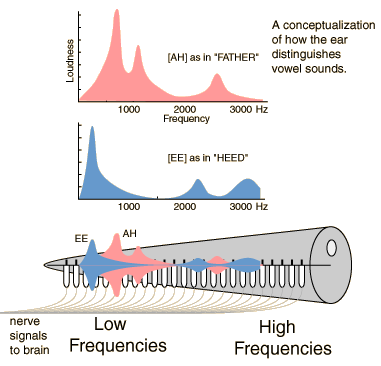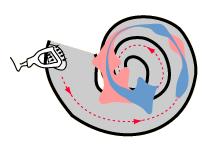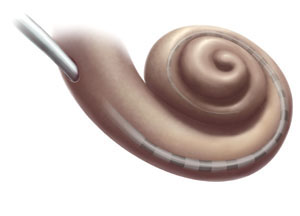Cochlear Implant
As an alternative to a hearing aid for profound hearing loss, the cochlear implant is under active investigation. In order to understand speech we rely on the cochlea in the inner ear as the body's microphone, converting the information in the sound waves to a series of electrical impulses that travel to the brain. The analysis of speech sounds relies on the separation of frequency information in the sound to electrical impulses from different parts of the basilar membrane of the cochlea. According to the place theory of pitch perception, the hair cells at different locations along the basilar membrane send impulses to the brain that form a frequency spectrum of the incident sound so that information like vowel sounds can be distinguished. If in the absence of normal function of this cochlear structure, we can recreate a pattern of electrical stimulation that will be sent to the brain to be interpreted as sound, we have the possibility of providing some approximation to the normal hearing function.
As a conceptualization of the normal function the coclear implant would be called upon to supplant, consider the process of distinguishing two vowel sounds.

To distinguish the two sounds, the cochlea must send to the brain a profile of intensity vs frequency with sufficient resolution to be provide distinctive differences between these sounds in the relevant part of the brain.
 A coclear implant must provide a distributed electrical stimulation to simulate the natural function in the cochlea. |  Cochlear Implant Cochlear ImplantNIH image, Medical Arts and Photography Branch. |
The following description is drawn from the website of the National Institute of Deafness and other Communication Disorders. They describe the implant as a "device that can help to provide a sense of sound to a person who is profoundly deaf or severely hard of hearing. The implant is surgically placed under the skin behind the ear. An implant has four basic parts:
- A microphone, which picks up sound from the environment;
- A speech processor, which selects and arranges sounds picked up by the microphone;
- A transmitter and receiver/stimulator, which receive signals from the speech processor and convert them into electric impulses;
- And electrodes, which collect the impulses from the stimulator and send them to the brain.
(Kerry-Lea Glass is acknowledged for investigative work on this topic.)
| Assessment of hearing loss | Hearing Aids |
Hearing concepts
Dangers of Loud Sounds
Reference

NIDCD of NIH
| HyperPhysics***** Sound | R Nave |